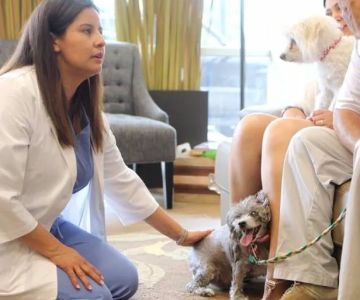Understanding Pet Behavior and Health
As a pet owner, one of the most rewarding experiences is forming a deep bond with your pet. Whether you have a dog, cat, or any other animal companion, understanding their behavior and health needs is crucial to ensuring a happy and fulfilling life for both you and your pet. In this article, we’ll dive deep into the various aspects of pet behavior and health, sharing tips, insights, and stories to help you become a better pet owner.
1. The Basics of Pet Behavior
Every pet has its unique personality, shaped by its breed, environment, and experiences. Understanding your pet's behavior starts with recognizing their natural instincts and habits. For instance, dogs are pack animals, so they tend to be social and protective. Cats, on the other hand, are more independent but can also form strong bonds with their owners.
One of the first things I learned when adopting my dog, Max, was how essential it is to read his body language. A wagging tail might seem like a sign of happiness, but it can also indicate excitement or nervousness. A raised fur can signal fear or aggression, while a relaxed posture typically means comfort and trust. Learning these subtle signals helps improve communication between you and your pet, making life much easier.
2. Addressing Common Behavioral Issues
Pets, like people, can develop behavioral problems that need attention. As a pet owner, it’s important to understand what might be causing these issues and how to address them effectively. Let me share a story about my cat, Whiskers, who had a habit of scratching furniture. It was frustrating, but instead of simply scolding her, I researched why cats scratch and found that it’s a natural instinct for marking territory and stretching their muscles.
To resolve this, I introduced a scratching post and used positive reinforcement to encourage her to use it. Over time, the behavior diminished. Many behavioral problems can be solved with patience and proper training. Common issues like excessive barking, chewing, or litter box problems can often be linked to anxiety, boredom, or lack of stimulation. Addressing the root cause and offering appropriate outlets for energy can help your pet improve their behavior.
3. The Importance of Regular Vet Visits
When it comes to pet health, regular veterinary check-ups are crucial. Just like humans, pets require routine health assessments to detect potential health issues early. I remember the first time I took Max to the vet for a routine check-up, I was nervous. But it turned out to be an opportunity to get professional advice on diet, exercise, and preventive care. It also gave the vet a chance to spot any early signs of health problems, such as dental issues or skin conditions.
Regular visits allow vets to update vaccinations, conduct blood tests, and check for parasites. They can also offer advice on weight management, as obesity is a growing concern for many pets. An overweight pet is at risk for a range of health problems, from joint issues to diabetes. Staying on top of their weight through a balanced diet and regular exercise can help extend your pet's life.
4. Understanding the Signs of Stress and Anxiety in Pets
Just like humans, pets can experience stress and anxiety. These emotions can manifest in a variety of ways, from excessive barking to destructive behavior. My own dog, Max, used to get nervous whenever we left him alone at home. His barking would escalate, and he would chew on furniture or shoes as a way to cope with his anxiety.
To address this, I began crate training him and left him with puzzle toys to keep him occupied. Slowly, he became more comfortable being alone for short periods. Pets who experience anxiety might also exhibit behaviors like excessive grooming, hiding, or changes in eating habits. If you notice any of these signs, it’s important to speak with your vet to rule out medical causes and explore behavioral therapies.
5. Nutrition and Diet for Healthy Pets
One of the most important aspects of pet health is proper nutrition. I’ve learned that feeding pets high-quality food tailored to their specific needs is essential for maintaining their health. Whether you have a puppy, an adult dog, or a senior cat, their nutritional requirements will vary.
For Max, I started him on a balanced, protein-rich diet when he was a puppy, which helped him grow strong and healthy. As he aged, I switched to a senior dog food formula to support his joints and digestive health. Similarly, Whiskers has a specialized diet to help maintain her weight and prevent kidney issues, which are common in older cats. Consult your vet to determine the best food for your pet’s breed, age, and health conditions.
6. The Role of Exercise in Pet Health
Exercise plays a huge role in maintaining a pet’s physical and mental health. Max, a high-energy dog, requires daily walks and playtime to burn off his excess energy. Without enough exercise, he can become anxious, destructive, and even overweight. On the other hand, Whiskers enjoys shorter bursts of play and loves chasing laser pointers around the house.
Regular physical activity keeps pets fit, prevents obesity, and reduces stress. It also provides mental stimulation, especially for intelligent breeds that need challenges to stay engaged. Consider interactive toys, agility courses, or puzzle feeders to keep your pet's mind active.
7. Grooming and Hygiene
Keeping your pet clean is an important aspect of their health. Regular grooming not only helps maintain your pet’s appearance but also contributes to their overall well-being. Max, for example, sheds a lot of fur, so regular brushing helps prevent mats and reduces shedding around the house. Grooming is also a great opportunity to check for signs of skin issues, parasites, or infections.
For cats, grooming is essential for preventing hairballs and maintaining healthy fur. Many cats, like Whiskers, enjoy being brushed, while others may need more time to get used to the process. Regardless of the breed, regular grooming is a fundamental part of keeping your pet healthy and happy.
8. Pet Health Emergencies: What to Do
Knowing what to do in a pet health emergency can be a lifesaver. I’ll never forget the time Max accidentally ate something toxic from the trash. I immediately called the emergency vet, who instructed me to bring him in right away. Thankfully, he was fine after treatment, but it was a reminder of how quickly things can go wrong.
Pet emergencies can range from ingesting harmful substances to sudden illness or injury. Having a first-aid kit for pets and knowing basic pet CPR can be valuable. Also, make sure you have the contact information for an emergency vet clinic available at all times. Quick action can often make the difference between life and death.
9. Aging Pets: Special Considerations
As pets grow older, their health needs change. Max, who’s now entering his senior years, requires more frequent vet visits and additional care. Senior pets often experience arthritis, reduced energy levels, and changes in their senses. It’s important to adjust their routine and environment to accommodate their age-related needs.
For Max, I’ve switched to softer bedding and added ramps to help him get into the car and onto the couch. I also provide joint supplements and feed him a diet designed for senior dogs. By staying proactive about his health, I’m able to help him age gracefully and comfortably.
Understanding your pet's behavior and health is a rewarding journey. With patience, care, and the right knowledge, you can ensure your pet leads a long, healthy, and happy life. Each pet is unique, and as an owner, it’s your responsibility to learn and adapt to their needs. By following these tips, you’ll be well on your way to becoming the best pet parent you can be!












